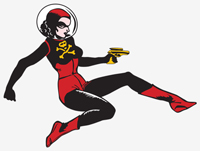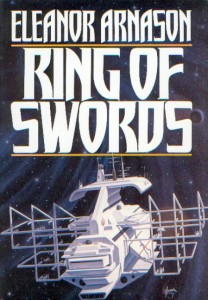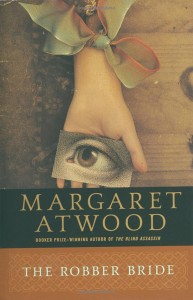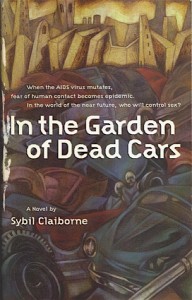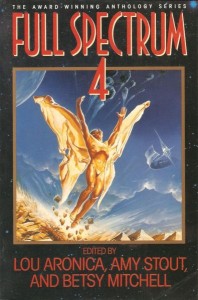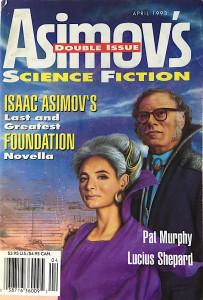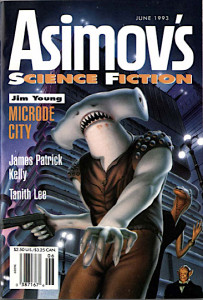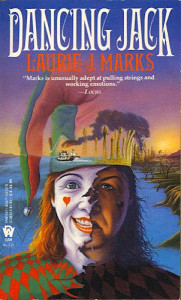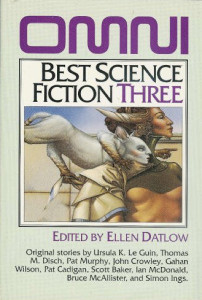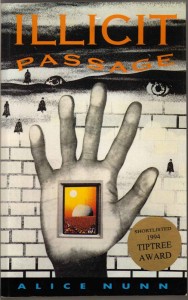In addition to selecting the winner, each jury chooses an Honor List (previously called a “Short List”). The Honor List is a strong part of the award’s identity and is used by many professors as a guide to creating syllabi and by many readers as a recommended reading list.
Honor List
The 1993 jury chose 10 works for the Honor List
A novel about human interaction with a culture where cross-gender relations are forbidden, and even contact is kept to a minimum. A lovely book, though the violent male, non-violent female aspects were a tad heavy-handed. Also suffers slightly from a read-the-next-book-in-the-series sort of ending. — Susan Casper This novel is both a rousing page-turner and idea-turner. The aliens in this book might be the technically advanced version of the aliens from Arnason’s Tiptree-winning novel, Woman of the Iron People. In both books, Arnason created an alien race whose social stability stems directly from the separation of male and female cultures. Both books are also based on the arguable premise that the male tendency toward violence differentiates gender. Given that premise, the culture and story that follows are fascinating. Both Hwarhath and Human culture must re-examine all their assumptions when the two races meet one another and begin negotiations to avoid war. — Jeanne Gomoll Both the narrators of this book use an understated, slightly self-mocking, casual tone which may lead the reader to take the story lightly. It is not a lightweight story. It is intellectually, emotionally, and ethically complex and powerful. A great deal of it is told by implication only, and so the moral solidity of the book and its symbolic and aesthetic effectiveness may pass a careless reader right by. The characters are mature, thoughtful, imperfect people, the settings are vivid, the drama is tense, and the science-fictional reinvention of gender roles is as successful as any I have ever read. The only physical gender difference between human and Hwarhath is that alien women are a little larger than the men; but the cultural gender differences are immense and their implications fascinating, both as a device for questioning human prejudice and convention, and as the basis for a very good novel. The shadowy presence of a third species runs through it both unifying its ideas and always putting all assumptions back in question-a beautiful symbolic device. A beautiful book. — Ursula K. Le Guin A story of alien contact where the male of the species is considered too volatile to have at home. Arnason examines some of our assumptions of gender by creating an alien race whose assumptions are just enough different than ours to bring ours into high relief. — Maureen F. McHugh Two young girls, minor characters in The Robber Bride, demand that all storybook characters-good and evil-be read as female. So too does Atwood portray all the main characters of The Robber Bride-good and evil-as female. This fictional warping of gender role expectations forces an understanding that is ironically more complex than the so-called real world in which behavior and archetype are frequently divided into two sets, female and male. The hint of possibly supernatural motivations, give me the excuse to include this wonderful novel on the Tiptree shortlist. — Jeanne Gomoll Though in this book Atwood does not extrapolate from gender construction as she did in Handmaid’s Tale, gender construction and the behavior and relationships forced on people by their gendered sexuality is always one of her central topics. In this case we have a major artist at the height of her powers telling a very grimm’s fairytale about what a Bad Woman does to Good Men and Good Women. It is a splendid novel, and far and away the funniest book this jury got to read. — Ursula K. Le Guin To me this is the most original book we read, and the most honest. The grim, repressive urban future seems familiar, conventional, but it grows less so as we read: its vivid, gritty reality is not borrowed, but discovered. What has happened to men, how women have adjusted to it, who the “carnals” are, all this complex matter is told with a mature and subtle simplicity, as the background to a strong love story and to the yet more powerful relationship of a daughter and a mother. — Ursula K. Le Guin Considers the very interesting premise that human sexual dimorphism (e.g., gender) is a physiological accident that might be swept away by a virus. A young girl reconsiders her body, her self and her relationship with everyone around her when she catches this virus. — Jeanne Gomoll A nineteen year old girl ! discovers that her boyfriend has given her a virus that makes her something not human, maybe not female, and the government wants to keep her quarantined. This story could have been the story of a victim but Duchamp has made Pat, her nineteen-year-old, both nineteen and anything but a victim. — Maureen F. McHugh This story is in Flying Cups and Saucers. Robertson has crafted a vivid portrait of a Native American society-the Sioux, at a time when the events of Little Big Horn are occurring just over the horizon. His main characters are two women, one enacting a warrior role and the other transvestite, that seem startlingly unlikely to our eyes. Robertson fearlessly avoids presenting his Sioux with politically correct Noble Savage stereotyping, giving us several thoughtless, cruel, even stupid examples, and ends up with a three dimensional picture of a fully human milieu. — Steve Brown A vivid story about Indian Wars of the last century that explores gender in both its look at a young woman who takes on the role of warrior to assuage her brother’s ghost, and her transvestite friend who has his eyes set on the white soldiers. — Susan Casper This story is interesting for its message that cultures based upon different understanding of humanity create dissonant communication when individuals from those cultures try to understand one another. Indians and Whites; women and men; White men and Indian women… — Jeanne Gomoll This story is in Flying Cups and Saucers. In Kelly’s vivid story, all of the interactive negotiations that transpire between lovers have been reduced to chemical transactions. One might think that this love story would end up as interesting as the purchase of a used car, but ultimately it is love story and a touching one. — Steve Brown A lovely story which makes the distinction between love and sexual attraction in a different way. A sweet love story and good science fiction. If gender-bending can be construed to mean the way men and women relate to each other sexually, as well as socially, this one nicely fills the bill. — Susan Casper a short story that starts by talking about love as if it were the interaction of chemicals and ends by making the interaction of chemicals a sweet and poignant story of love. — Maureen F. McHugh This story is in Flying Cups and Saucers. Dancing Jack is a wonderful fantasy, with a very unusual portrayal of magic and powerful portrayals of three women characters-the heroes who rescue their post-plague world. This is a wasteland story: saved not be a fisher king or a single knight, but by the combined magics of a riverboat pilot, a farmer, and a toymaker. The land is infertile, crops are not growing, animals die; people have mostly given up. The magic with which these three women reclaim life for themselves and their land is the lesson that acceptance of pain brings the possibility of joy. It turns inside out the formula of the quest and the knight-hero with gender-bending insights. — Jeanne Gomoll I thoroughly enjoyed this very realistic fantasy, but found no genderbending in it: just a fine depiction of competent, independent women working, and a very satisfying, lesbian love-story. Fantasies about grown-ups are very rare; and this is one. — Ursula K. Le Guin McDonald has taken a well-worn fictional path, that of the non-human race that has always lived in parallel with us (usually responsible for the generation of vampire mythology), and reworked it into something new. His “vampires” have a sophisticated form of pheromonal communication and an ambiguous concept of gender. Their interaction with humans is compelling, and tragic. — Steve Brown Aliens/changelings/an unrecognized third sex? McDonald doesn’t quite say where these gender-shifting people come from, but they pay a high price for a desirability far beyond that of full-time women. Touching and well-written. — Susan Casper Any story that includes in its first sentence, “Mother says he can remember Grandmother taking him…” grabs my genderbending radar. It’s a suspenseful story about aliens-among-us who change their gender at will from female to male to hermaphrodite, and who are subject to an awful AIDS-like disease. I liked it a lot. — Jeanne Gomoll This story is in Flying Cups and Saucers. One of my favorite novels of recent years, Illicit Passage concerns the actual mechanics of a feminist revolution, a revolution from within. As the individuals in the asteroid mining town in Nunn’s novel learn self-confidence, their lives change. And as the people organize, the social order changes. The establishment panics and looks for “the usual suspects”-the revolutionary agitators, the bomb-throwers, and entirely misses the secretaries, mothers, factory workers, and servants plotting radical change right under their noses. Illicit Passage is a novel of mistaken assumptions, misdirected expectations. In fact, we never actually hear the main character (Gillie) speak. We only learn about her from characters who dislike or are intensely jealous of her. That we end up liking her very much anyway, in spite of the strongly biased points of view of the other characters, only strengthens our admiration for her. — Jeanne Gomoll This novel of an alien surgically transformed into a human woman who is gradually reverting-sloughing off one human attribute after another-and the confused human man who thought he was in love with her, is a dark and wrenching experience. Park explores the shadowy alleyways of the city of gender and studies the age-old imperialist clash between rich and poor civilizations. — Steve Brown To me this ambitious and complex book is ultimately a failure both as a novel and as an exploration of gender. The self-conscious tonelessness of the narrative voice imposes a real lack of affect. As gender exploration it is seriously handicapped by the fact that there are no women in it, except a girl who is fucked on page 46 and killed on page 49. The alien called “Katherine” is supposed to have been transformed into a female or a woman, but appears, to me, merely genderless from beginning to end. The setting and mood is standard neo-Conrad-on-distant-planet. — Ursula K. Le Guin Simon, a human diplomat, falls in love with Katherine, a gifted pianist and more importantly, an alien who in ‘her’ natural state is not female. As a series of events deprive Katherine of the drugs that keep “her” human, she becomes less and less so. The book is written from multiple points of view and it becomes clear that while Simon continues to find human motivations in her actions, Katherine is more alien than he wants to know. — Maureen F. McHughRing of Swords, Hwarhath Book 1, by Eleanor Arnason (Tor, 1993)
Work Information
Title: Ring of SwordsAuthor: Eleanor ArnasonSeries:
Series Title: HwarhathSeries Number: 1Publisher:
Publisher Name: TorCountry: USYear: 1993The Robber Bride by Margaret Atwood (Bantam Books, 1993)
Work Information
Title: The Robber BrideAuthor: Margaret AtwoodPublisher:
Publisher Name: Bantam BooksCountry: USYear: 1993In the Garden of Dead Cars by Sybil Claiborne (Cleis Press, 1993)
Work Information
Title: In the Garden of Dead CarsAuthor: Sybil ClaibornePublisher:
Publisher Name: Cleis PressCountry: USYear: 1993Motherhood, Etc. by L. Timmel Duchamp (Bantam Spectra, 1993)
Work Information
Title: Motherhood, Etc.Author: L. Timmel DuchampCollection:
Title: Full Spectrum 4Editors: Lou Aronica, Amy Stout, Betsy MitchellPublisher:
Publisher Name: Bantam SpectraCountry: USYear: 1993The Other Magpie by Rodrigo Garcia y Robertson (Bantam Doubleday Dell Magazines, 1993)
Work Information
Title: The Other MagpieAuthor: Rodrigo Garcia y RobertsonCollection:
Title: Asimov's Science Fiction April 1993Editor: Gardner DozoisPublisher:
Publisher Name: Bantam Doubleday Dell MagazinesCountry: USYear: 1993Chemistry by James Patrick Kelly (Bantam Doubleday Dell Magazines, 1993)
Work Information
Title: ChemistryAuthor: James Patrick KellyCollection:
Title: Asimov's Science Fiction June 1993Editor: Gardner DozoisPublisher:
Publisher Name: Bantam Doubleday Dell MagazinesCountry: USYear: 1993Dancing Jack by Laurie J. Marks (DAW Books, 1993)
Work Information
Title: Dancing JackAuthor: Laurie J. MarksPublisher:
Publisher Name: DAW BooksCountry: USYear: 1993Some Strange Desire by Ian McDonald (OMNI Books, 1993)
Work Information
Title: Some Strange DesireAuthor: Ian McDonaldCollection:
Title: Omni Best Science Fiction ThreeEditor: Ellen DatlowPublisher:
Publisher Name: OMNI BooksCountry: USYear: 1993Illicit Passage by Alice Nunn (Woman's Redress Press, 1992)
Work Information
Title: Illicit PassageAuthor: Alice NunnPublisher:
Publisher Name: Woman's Redress PressCountry: AustraliaYear: 1992Coelestis by Paul Park (Harper Collins, 1993)
Work Information
Title: CoelestisAuthor: Paul ParkAlternate Title:
Title: CelestisPublisher: TorCountry: USYear: 1995Publisher:
Publisher Name: Harper CollinsCountry: UKYear: 1993
